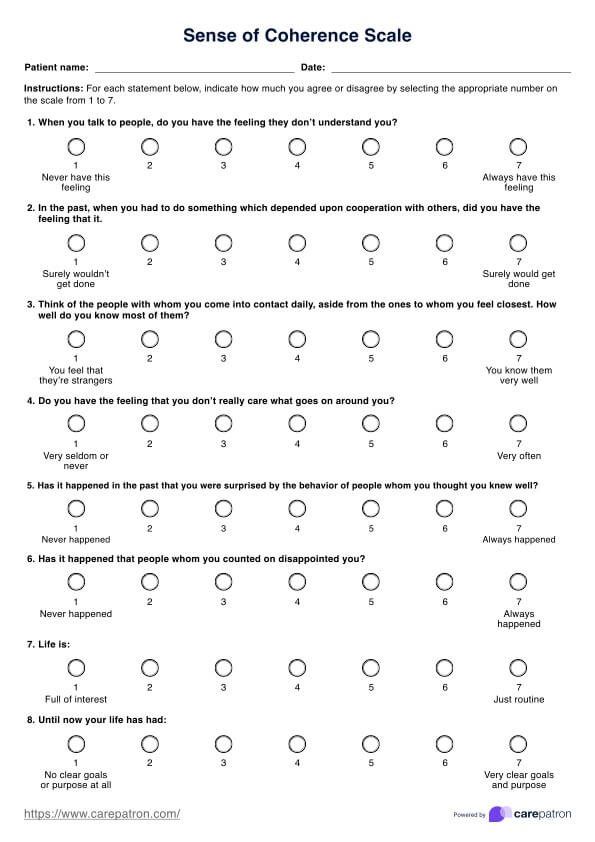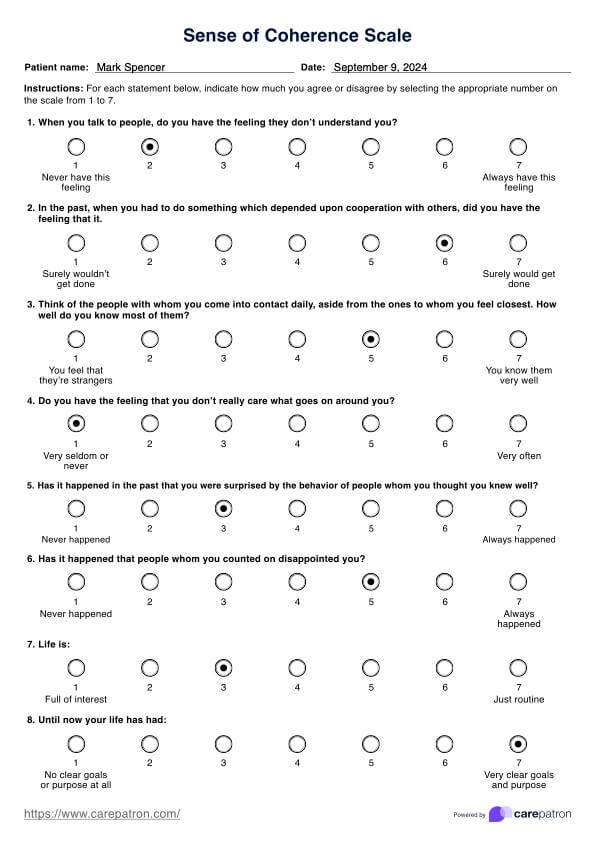Sense of Coherence Scale
The Sense of Coherence Scale measures one's ability to deal with stress and challenges. Download Carepatron's free PDF and learn more about how this scale.


What is the sense of coherence theory?
Aaron Antonovsky developed the sense of coherence theory, a concept within health promotion research that explores how people manage stress and maintain good health. Central to Antonovsky's sense of coherence theory is that a strong sense of coherence helps individuals effectively navigate life’s challenges, enhancing their physical and mental well-being. This theory is particularly relevant in public health and community health settings, where understanding how individuals cope with stress can lead to improved health-related quality outcomes.
The sense of coherence is composed of three components: comprehensibility, manageability, and meaningfulness. These elements collectively determine how well an individual perceives their life as structured, manageable, and meaningful, which in turn influences their overall health status.
Sense of Coherence Scale Template
Sense of Coherence Scale Example
What is the Sense of Coherence Scale?
The Sense of Coherence Scale is a tool designed to measure how individuals perceive and respond to everyday life challenges. The scale is rooted in Antonovsky’s theory, which suggests that a strong sense of coherence helps individuals effectively use internal and external resources to maintain their mental health and overall well-being. The original version of the scale, known as the Orientation to Life Questionnaire, consists of 29 items (SOC-29), which assess three key components: comprehensibility, manageability, and meaningfulness. These components reflect how well an individual understands their environment, feels equipped to handle challenges, and finds meaning in life.
The SOC-29 is scored on a semantic scale ranging from 1 to 7 points, with the total score ranging from 29 to 203 points. The questionnaire has been utilized in over 32 countries and translated into at least 33 languages, featuring a minimum of 15 distinct versions. It has a Cronbach’s α values range from 0.70 to 0.95, indicating strong reliability (Eriksson, 2005).
Antonovsky later developed a shorter version, the SOC-13, which includes 13 items with scores ranging from 13 to 91 points. Both versions are designed to provide a single total score rather than separate component scores, as Antonovsky believed that the overall sense of coherence is what guides health promotion efforts and influences health-related factors.
How to use our Sense of Coherence Scale template
Carepatron's Sense of Coherence Scale template is designed to help healthcare professionals easily assess a patient's sense of coherence. By following the steps below, medical professionals can effectively integrate this tool into their practice to social support for mental and physical health evaluations.
Access the scale
To begin, access the Sense of Coherence Scale template provided within this guide. This easy-to-use template is available for download and can be incorporated directly into your patient assessments, streamlining the process of measuring a patient’s sense of coherence.
Review the scale
Before using the scale with patients, review the template to familiarize yourself with its structure and the scoring system. Understanding the scale's components ensures accurate administration and interpretation of the results, leading to more informed health promotion strategies.
Introduce the scale to the patient
Introduce the Sense of Coherence Scale to your patient by explaining its purpose and relevance to their overall health. Clarify that the scale will help identify how they perceive and manage life’s challenges, which can inform tailored approaches to improving their mental and physical well-being.
Patient completes the scale
Allow the patient to complete the scale independently, ensuring privacy and confidentiality. Encourage them to answer honestly and without overthinking.
Score the scale
Once completed, score the scale using the provided instructions. This will determine the patient's level of sense of coherence and provide valuable insights into their ability to cope with stressors and maintain good health.
Discuss results with the patient
Schedule a follow-up appointment with your patient to discuss their results. Use this time as an opportunity to further assess their sense of coherence and develop personalized strategies for improving it if needed.
Scoring and interpretation
The Sense of Coherence Scale is scored using a 7-point Likert scale, where each item is rated from 1 to 7. To obtain the total score, sum the ratings for all items on the scale. This yields a score ranging from 7 to 203 (Eriksson & Mittelmark, 2017).
Higher scores reflect a greater sense of coherence, indicating that an individual perceives their life as more comprehensible, manageable, and meaningful. Interpreting the total score helps in understanding the individual's overall resilience and ability to handle life’s challenges effectively.
Next steps
After administering the Sense of Coherence Scale, medical professionals should take several key actions to guide health promotion and enhance patient outcomes.
First, review the patient's total score to assess their sense of coherence, which can provide insights into their psychological well-being and ability to cope with stress. Use this information to tailor health education and develop personalized coping strategies that address their specific needs.
Additionally, consider integrating the findings into broader health promotion efforts that address different age groups and health behaviors. For patients with lower scores, explore options for increasing their sense of coherence through targeted interventions and support.
Finally, document and monitor changes over time to contribute to future research on how sense of coherence impacts long-term health outcomes. This proactive approach ensures that the Sense of Coherence Scale is used effectively in a health-promoting manner, enhancing overall patient care.
References
Eriksson, M., & Mittelmark, M. B. (2017). The sense of coherence and its measurement (M. B. Mittelmark, S. Sagy, M. Eriksson, G. F. Bauer, J. M. Pelikan, B. Lindström, & G. A. Espnes, Eds.). PubMed; Springer. https://www.ncbi.nlm.nih.gov/books/NBK435830/
Eriksson, M. (2005). Validity of Antonov sky’s sense of coherence scale: A systematic review. J Epidemiol Community Health , 59(6), 460–466. https://doi.org/10.1136/jech.2003.018085
Commonly asked questions
The Sense of Coherence Scale measures an individual's overall perception of how comprehensible, manageable, and meaningful their life is. Health professionals use this scale to assess how effectively people cope with stress and challenges, reflecting their psychological resilience and overall health.
The three factors of sense of coherence are comprehensibility, manageability, and meaningfulness. Comprehensibility refers to how well individuals perceive their life as structured and predictable, manageability relates to their ability to handle challenges, and meaningfulness involves finding purpose and significance in their experiences.
A strong sense of coherence indicates that an individual perceives their life as well-structured, manageable, and meaningful, leading to better coping with stress and improved psychological well-being. It reflects a high level of resilience and an effective use of internal and external resources.
Levels of coherence range from low to high, with low coherence indicating difficulty in finding life’s events understandable, manageable, or meaningful. High coherence reflects a strong ability to perceive life’s challenges, like mental health problems, as comprehensible, manageable, and purposeful, contributing to better health outcomes and life satisfaction.




















-template.jpg)



















































































